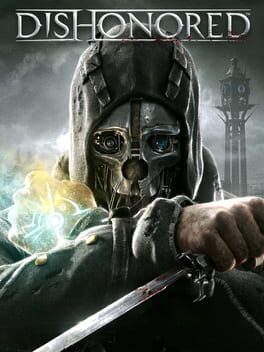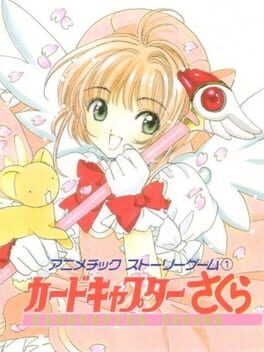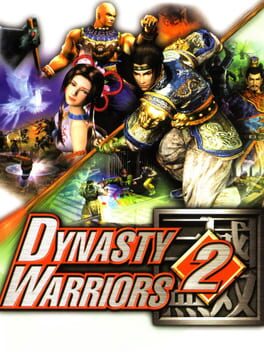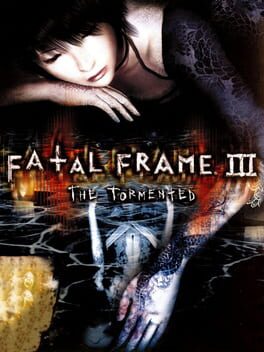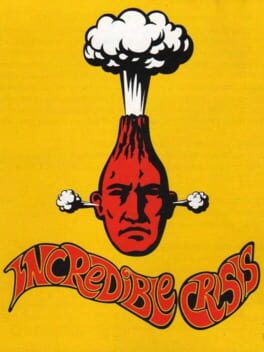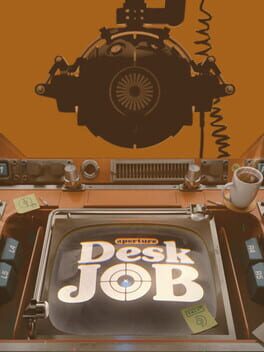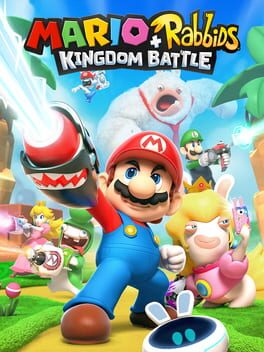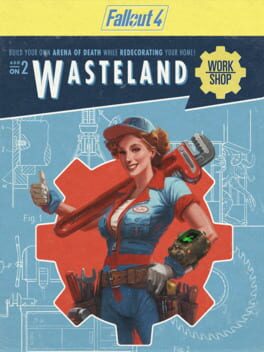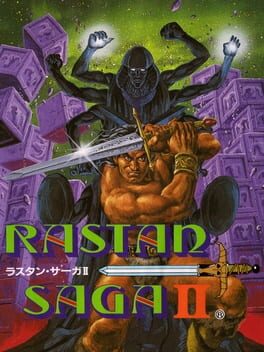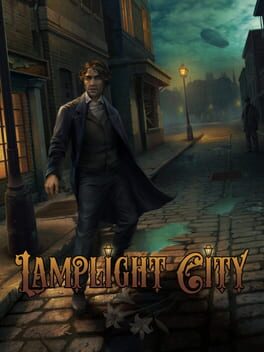TGA_backloggd
137 Reviews liked by TGA_backloggd
Dishonored
2012
Dynasty Warriors 2
2000
The Original Sworn Brother Simulator: hours upon hours of chaos, hordes upon hordes of hapless soldiers as blood sacrifice for the honor, glory, and jealous one-upmanship of the Three Kingdoms' ruthless, sexually repressed macho men. Sure, I've heard of the Peach Garden Oath…but how about that whole Shu roster looking like the future winners of Eurovision Asia? Or the way Lu Bu and Zhang Liao glance at each other while riding out to stop Cao Cao? And why do I gotta keep pounding on these guys to get meat buns and stat upgrades outta them?! I take back last month's comments about *Romance of the Three Kingdoms VII—this one's the real Bromance. It also just happens to be a major turning point for Koei, a "safe" brand that ventured out of its RPG, sim, and strategy comfort zones to finally break into the mid-range action market. The big cuddly bear of Japan's game industry started laying down the fight; few knew where musou would go.
I had my reservations going into my Normal skill playthrough of Dynasty Warriors 2, having heard about its jank, slim content, and overall difficulty—these fears were validated, but I'm liking it more after trying part of it again on Hard. Faithfully covering the Three Kingdoms in any action game up to this point meant focusing on the set-piece battles and character stereotypes derived from Luo Guanzhong's classic novel, something which Koei's then youngest division Omega Force (OF) had to translate into mainstream 3D polygon game terms. It's natural that they'd combine the arcade beat 'em up with a light strategy layer. What's special about Shin Sangokumusou are the ways in which it recycles the original Dynasty Warrior, an average versus fighter reborn as the unlikely usurper of trends in beat 'em up design started by Dynamite Deka and SpikeOut. This game ultimately saw much success for OF, its talented staff led by Akihiro Suzuki and Kenichi Ogasawara, and an odd first impression for PS2 adopters expecting something more substantial. These days players tend to view DW2 strictly as a curiosity, and hardly without reason. I just think there's a bit more going on here.
| Yellow Storm |
Romance of the Three Kingdoms looms high in East Asian cultural history, hence all the different ways it's been retold across comics, film, music, and games. (Arguably only Water Margin aka All Men Are Brothers supersedes it in influence—see every shonen manga ever.) In the video game realm, Capcom was first to take a more action-oriented approach to portraying the Three Kingdoms conflict, first with a dramatic post-Dragon Quest series called Tenchi wo Karau (Destiny of the Emperor), and then the pre-Final Fight belt-scroller Dynasty Wars in 1989. By contrast, Koei's grand strategy treatment, initially restricted to Japanese home computers, traded out flash for in-depth systems, letting players role-play as provincial rulers far away from the battlefield. How could these divergent angles meet to make a flashy but accurate, strategic but skillful rendition of the saga?
Omega Force started as Koei's fourth internal division (hence "force", which reads in Japanese as "fourth"), and it saw Suzuki and Ogasawara attempting to solve the aforementioned problem. Though decently regarded in 1997, Dynasty Warriors didn't become the phenomenon they hoped, crowded out by other weapons-based fighters like Soul Edge and Battle Arena Toshinden. (Still better than the results for Destrega…) The team would find more success with WinBack, proving they could bring innovations to 3D third-person action and engage with arcade stylings without trend-chasing. While Suzuki and other veterans from the early-'90s brought their historic knowledge and development experience to the group, Ogasawara represented the new batch of Koei recruits ready to build something console players could uniquely enjoy, rather than PlayStation owners seemingly getting the scraps of PC releases. He saw his colleagues playing RTS games during lunch breaks and was inspired to make a prototype of the archetypal musou game, with single fighters now accompanied by tiered ranks of followers all tied into a morale system which players manipulate to win the larger battle. [1]
It had already taken a nascent Omega Force around a year and a half to make just their first game…once they got their hands on PS2 development kits, there was no time to lose if they wanted the sequel out around launch! (The main team under Koei head Yoichi Erikawa were already wrapping up Kessen for that crucial March 4th, 2000 launch date.) So it goes that Dynasty Warriors 2 narrowly became one of the the system's first 25 releases and proceeded to sell very well. New adopters quickly got a taste of the opening level, a congested assault on the Yellow Turban Rebellion which brought the ailing Han Dynasty to its knees and decorated the careers of many warriors old and young. Pounding heavy metal music, loud and chunky martial arts ambiance, and a tight balance between difficulty and power fantasy all came together despite the odds. It'd be just a year until Koei & OF promptly hurried a sequel to market, knowing they had a new franchise in the making. Critics were impressed that the company had produced anything so unlike their typical history software, feeling more like the work of arcade-based developers rather than home-oriented ones [2].
| Killing Time |
Dynasty Warriors 2 gives you 28 generals from the Wei, Wu, and Shu forces (plus "rogue" players like Lu Bu) to play across 8 battles, with most characters sharing similar story mode progression. Not everyone's available from the start, unlocking as you play with fighters from all sides or achieve feats like earning a thousand kills at Hu Lao Gate. This amount of content hardly seems light until you realize just how many fighters share the same movesets. In musou/fighting game jargon, these are clones with only secondary differences like stat assignment and different hitboxes. Each character's got health, attack, defense, and "musou" stats affecting their abilities in combat, and each variety of character can combo their square attacks up to four moves, or follow that regular combo with a charge move (ex. a "charge 3" (C3) = 3 □ + ∆).
Fighting itself is something Dynasty Warriors 3 and its successors would greatly improve, though I find it fine in this early form. Chaining moves doesn't take a whole lot of practice, or even that much mashing once you've internalized the animation timings for attacks. Actually hitting foes can sometimes be fickle with certain weapons, but that's usually just an issue when trying to C1 (juggle) a gate captain or general. Swap guys often, though, and it'll quickly become clear how busted certain combos of moveset and weapons can become. Let's put aside Lu Bu and talk about Dian Wei. His big axe should slow everything way down, yet he runs about the same speed as most other guys (poor Xu Zhu) and has a broken AF C3 where the axe becomes a veritable boomerang. When a fighter's only flaw is this AoE move not always working as it should (the axe can't fly behind the camera frustum and hit enemies), Now That's What I Call Imbalancing! The gulf in performance between crowd-control gods and the weaker units like Zhuge Liange wouldn't be this pronounced in the series for some time.
Archery and mounted combat are also introduced in this installment, albeit with issues that would plague them up until the later PS2 games. The former involves stopping still and holding R1, transitioning to a slow and clunky first-person view where you can periodically string single arrow shots, regular or charged. In practice, bow play gets the most use against guard tower turrets and bosses you shouldn't approach until low on health (again, Lu Bu). It's too inflexible and awkward to use for anything else vs. closing in. Meanwhile, cavalry charges go haywire half the time you try. Enemies will gladly jump to knock you off, with varying success due to hitbox weirdness. Running into large groups will often provoke your steed into rearing up and losing momentum, which can lead to someone dismounting you. And killing enemies via trampling doesn't net you kills, because only weapons kill people apparently! This sucks for characters like Xiahou Yuan and Ma Chao, masters of archery and equestrian respectively, who don't get to shine despite debuting in this game. At least jumping is still useful for level traversal, even if there's a surprising amount of invisible walls preventing you from hopping onto stairs from the side, among other things…
Grinding's a dirty word in the musou fandom, insofar as no one quite agrees on how much padded-out gameplay exists in these titles. Dynasty Warriors 2 easily earns the accusation. Ho boy can this one become a grind if you're unaccustomed to a couple of things. For starters, the game's mostly designed for players to take a character between their Musou Mode playthrough and Free Mode runs—usually from Easy or Normal difficulty depending on playstyle—before being able to try Hard mode comfortably. This becomes a trend throughout the PS2 games, though they've solved the pacing issues by Dynasty Warriors 5 with mechanics like out-of-battle weapon tuning. So that's fine, it's just more kickass brawling action, right? Maybe, but there's a pernicious little thing that officers major and minor love to do: repeatedly heal up before they die. Every non-generic officer (plus the gate captains) gets a limited but scaling supply of dim-sums and other power-ups, used randomly but frequently when recovering from knockdown. The closer they get to dying, the more likely they use an item! This uses the typical combo flow against players, rather than to their benefit, and can throw a lot of people off. I don't like this system in practice, despite how it cleverly encourages cheesy tactics like weak arrows or refusing to finish combos. It's something I haven't missed going into later games, but there's the seed of a clever idea here.
I'm happy to say the animation quality and kinaesthetics haven't aged much at all, notably when using the game's special musou attacks. Should you get stuck on the other end of a brutal assault, a timely musou can change the outcome in just several seconds. Sword wielders slash through the crowd before launching everyone around them with a single swipe; ax and club battlers pummel unlucky soldiers into a pulp with plenty of knockback; and those cultured fan users basically unleash black magic in a flash. The spectacle's always exhilarating, as is the freedom these specials give players when dueling the nastier opponents. While this game has a subtle auto-lock tendency, influencing your character to hone in on a single enemy at a time, it's much less restrictive than how Omega Force implemented this in the following two games. Dynasty Warriors 2 cares more about making each link of hits satisfying to pull off than keeping the player down for the AI's sake. It becomes tempting to leap around, sucker-punching guys from the air just to watch them fall to the floor as you prepare a deadly finisher. When all else fails, one can always guard attacks by holding the camera face button (L1), which works as stiff but reliable as ever.
Put it all together and the magic starts to happen. Charismatic leaders advance across plains, canyons, farmlands, and fortresses with retinues in tow, with enough numbers to make this world feel alive and bustling. The iconic moments are all here: crunchy impacts as combo finishers send troops flying, crashing into each other like ragdolls; rivals appear from the fog of war to challenge you, either to win and end the match or fall and herald your victory; gates open as officers retreat, traps are sprung right upon your allies' feet, and the cadence of battle hits climax. It's hard to explain how this game, with its aforementioned core flaws and priorities, manages to enthrall me so much. Sure, I could whinge about the genre's perceived repetition or this game clearly being a prototype of things to come, but OF really understood how these games can and should be paced. I can have fun going full 1v1000 with OP fighters like Lu Bu and Dian Wei, but also get a kick out of managing upsets with sub-optimal choices like Sun Shang Xiang or Jiang Wei—the "what if?" attraction of future titles clearly existed this far back. Role-playing beat 'em ups weren't new, but this variation sure was.
| Divine Wind |
Musou games live or die based on their game loop, and strong combat doesn't mean as much without a similarly worthwhile campaign that challenges players, maintains variety, and delivers that sense of martial adventure. Again, here's where Dynasty Warriors 2 shows its budget and design limits, as Omega Force needed to spend precious resources on getting all those scores of units to render at the expense of level design. It arguably wouldn't be until Dynasty Warriors 5 that Koei found an ideal ratio of asset and SFX complexity to level density and novelty. What we do have in DW2 is quite good regardless, as shown in the multi-layered, ambush-laden attack on Zhang Jiao's peasant rebels. Allied and enemy forces always start from their own forts and hidey-holes, accompanied by reinforcement points leading off the map. Most mission goals revolve around defeating the main enemy commander, but raising your side's morale (let alone deflating the enemy's) often becomes most important of all.
There's a common line of debate about old vs. new Dynasty Warriors (and musou in general) about how important or relevant it should be to fight within your army, rather than steamrolling ahead with nary a consequence. I tend to prefer the former myself, something which this game promotes by having very aggressive AI on Normal and Hard difficulties. Later games make the 1v1000 meme real largely by empowering player characters and dumbing down AI fighters, but almost all the PS2-era musou titles preferred to have peons and corporals interrupt your combos or even use special attacks to weigh you down. It's truly dangerous to wander away from friends and get surrounded; I've lost a couple times while playing Yi Ling and Wu Zhang Plains on Hard this way. Getting juggled sure isn't as fun as juggling them yourselves! For lack of something more complex like holding/sieging bases or keeping supply lines established the further in you go, this mix of active AI (without gimped movesets) and limited on-map resources like health or save points hems the player in from trivializing campaigns.
Taking out officers and large groups of foes, preferably via long combo chains, yields item drops affecting either temporary stats (e.g. current health and arrow stock) or permanent ones. Some of these also pop up from busted crates or pots lying around settlements, but it's often viable to forage these from the killing fields as you go. Something I really like are the limited-time stat boosting power-ups which any musou fan will recognize: armor and attack buffs, drinks to restore your special meter, etc. Encouraging players to keep moving and plow forward, skipping from one skirmish to another while making optimal use of item drops…It Just Works™. Another thing enriching the gameplay is the battle UI, displaying informative chyrons whenever you hit an "X units defeated" milestone or when an ally/enemy unit's morale rises or declines. Information travels faster to our screens than could possibly have reached officers' eyes and ears all the way back in the past, and that's okay. It's yet one more decidedly unrealistic element which brings players into the stressed, frenzied state of mind that anyone fighting on these fronts would have had. There's always something going on, for better or worse, and late-game stages can really test one's endurance.
And even with its teething problems, Dynasty Warriors 2 makes good use of its large stages and flashy art direction to compensate for things outside of Omega Force's budget or expertise. I can list quite a few set-pieces and vistas that'll stick with me all throughout the series: the claustrophobic gauntlet at Hu Lao Gate, Zhang Fei's bridge standoff at Changban, the fire attack raging across Yi Ling, and the dread expanse of death at Wu Zhang… All these levels would eventually improve and expand over the years, with more events and intricate pathways to explore, but it's cool to experience them in this formative state. It's just a shame that textures are comically low-res and that the engine can't yet gracefully handle level-of-detail loading, leading to a lot of pop-in and disappearing combatants which adversely affects the game loop. Thankfully you're always able to see your fighter, one of many flamboyantly designed heroes balking at RoTK's conservative character design ethos. Even the most conservatively dressed fellas here look amazing, yet still believable enough (if ceremonial outfits count as wartime or official attire). The cast only gets more colorful and distinct from here on, referencing famous legends about individuals like Xiahou Dun or Gan Ning to embellish them.
| The Boundless Ground |
Maybe the best example I can give for Dynasty Warriors 2 remaining relevant today is its soundtrack. Omega Force's then novice musician MASA (aka Masayoshi Sasaki) banged out one of the most era-defining hard rock soundtracks in the PS2 library, all without having played a Koei game before. [3] From the opening march upon the Turbans, across the splattered red cliffs at Chi Bi, and at the bitter end of generation-spanning warfare, MASA's percussive guitars, synths, and rhythms attune every play session to the pulse of confrontation. The grunge and Y2K electronica of everyman PlayStation games in years preceding gave way to a gentler mix of genres with improving production values, even from inexperienced developers like him. These songs are so fun and memorable that Dynasty Warriors 3 imports almost all of them with slight rearrangements. Nor is the foley any slouch, either. Hit effects, hoof-steps, and rancorous environmental sounds pervade every inch of the game's missions, all without blaring over the tunes.
I've been giving this game a lot more praise, or at least apologizing for its shortcomings, compared to most opinions I read in the current year. It's a hard one to get into now because it's been so thoroughly obsoleted by its sequels, save for hacking potential (seriously, DW2 has some of the most absurd cheats and custom fan levels I've seen from a musou game). For new Warriors fans, I'd say there's a bit more here to experience than just a history piece. Oddities like cinematic kill cams, on-map save slot collectibles, and musou canceling (denying a unit's special with your own!) give this entry a more arcade-y feel than would become the norm. The sheer moxie of infantry doing anything to hitstun you outdoes the harder PS2-era games like DW 3 or DW 4. And while it's low on overall content, the unique level designs for stages like Yellow Turbans and Chi Bi keep me coming back. Bonus points for carrying a smaller filesize footprint than the following games, too! I guess that's what happens when you've got minimal voice acting and cutscenes (both of which are surprisingly less awkward than in Dynasty Warriors 3 for whatever reason).
Dynasty Warriors 2 set a standard for console-bound 3D beat 'em ups to follow. While SEGA and Capcom eked out some '90s arcade-style examples of the genre up until the HD transition, even the latter ended up creating Sengoku Basara to meet Koei's new cash cow on its own terms. The newfound emphasis on influencing a larger world at war, rich in unlockables and storied presentation, made for a compelling combination of elements that Omega Force did better than anyone for quite some time. Eventually there'd be competition from the likes of Ninety-Nine Nights, Kingdom Under Fire: The Crusaders, or the ill-fated Demon Chaos, but Dynasty Warriors ended up having to worry more about OF's own Samurai Warriors series more than anything. The musou genre lost its freshness fast, too, with criticism most often coming from jaded fans or critics perceiving stagnation within these core series. Yet it's still a hugely successful part of the AA+ gaming market today, and it's meaningful to trace these ups and downs back to their source. If you've bounced off DW2 in the past, maybe consider a retry; there's some very nice PCSX2 cheat codes to enhance graphics and playability if desired, too.
| Sources |
[1] 任天堂ホームページ. “社長が訊く『ニンテンドー3DS』ソフトメーカークリエーター 篇|ニンテンドー3DS|任天堂.” Nintendo Co., L. Accessed January 22, 2024. http://www.nintendo.co.jp/3ds/interview/creators/vol16/index2.html.
[2] “鈴木 亮浩 | 社員インタビュー | 新卒採用2017 | コーエーテクモ ホールディングス.” Koei Tecmo Holdings Co., Ltd., January 4, 2016. https://web.archive.org/web/20160104172459/https://www.koeitecmo.co.jp/recruit/graduate/2017/member/vol-01/.
[3] “佐々木 優嘉 | 社員インタビュー | 新卒採用2017 | コーエーテクモ ホールディングス.” Koei Tecmo Holdings Co., Ltd., January 4, 2016. https://web.archive.org/web/20160104172514/http://www.koeitecmo.co.jp/recruit/graduate/2017/member/vol-03.
I had my reservations going into my Normal skill playthrough of Dynasty Warriors 2, having heard about its jank, slim content, and overall difficulty—these fears were validated, but I'm liking it more after trying part of it again on Hard. Faithfully covering the Three Kingdoms in any action game up to this point meant focusing on the set-piece battles and character stereotypes derived from Luo Guanzhong's classic novel, something which Koei's then youngest division Omega Force (OF) had to translate into mainstream 3D polygon game terms. It's natural that they'd combine the arcade beat 'em up with a light strategy layer. What's special about Shin Sangokumusou are the ways in which it recycles the original Dynasty Warrior, an average versus fighter reborn as the unlikely usurper of trends in beat 'em up design started by Dynamite Deka and SpikeOut. This game ultimately saw much success for OF, its talented staff led by Akihiro Suzuki and Kenichi Ogasawara, and an odd first impression for PS2 adopters expecting something more substantial. These days players tend to view DW2 strictly as a curiosity, and hardly without reason. I just think there's a bit more going on here.
| Yellow Storm |
Romance of the Three Kingdoms looms high in East Asian cultural history, hence all the different ways it's been retold across comics, film, music, and games. (Arguably only Water Margin aka All Men Are Brothers supersedes it in influence—see every shonen manga ever.) In the video game realm, Capcom was first to take a more action-oriented approach to portraying the Three Kingdoms conflict, first with a dramatic post-Dragon Quest series called Tenchi wo Karau (Destiny of the Emperor), and then the pre-Final Fight belt-scroller Dynasty Wars in 1989. By contrast, Koei's grand strategy treatment, initially restricted to Japanese home computers, traded out flash for in-depth systems, letting players role-play as provincial rulers far away from the battlefield. How could these divergent angles meet to make a flashy but accurate, strategic but skillful rendition of the saga?
Omega Force started as Koei's fourth internal division (hence "force", which reads in Japanese as "fourth"), and it saw Suzuki and Ogasawara attempting to solve the aforementioned problem. Though decently regarded in 1997, Dynasty Warriors didn't become the phenomenon they hoped, crowded out by other weapons-based fighters like Soul Edge and Battle Arena Toshinden. (Still better than the results for Destrega…) The team would find more success with WinBack, proving they could bring innovations to 3D third-person action and engage with arcade stylings without trend-chasing. While Suzuki and other veterans from the early-'90s brought their historic knowledge and development experience to the group, Ogasawara represented the new batch of Koei recruits ready to build something console players could uniquely enjoy, rather than PlayStation owners seemingly getting the scraps of PC releases. He saw his colleagues playing RTS games during lunch breaks and was inspired to make a prototype of the archetypal musou game, with single fighters now accompanied by tiered ranks of followers all tied into a morale system which players manipulate to win the larger battle. [1]
It had already taken a nascent Omega Force around a year and a half to make just their first game…once they got their hands on PS2 development kits, there was no time to lose if they wanted the sequel out around launch! (The main team under Koei head Yoichi Erikawa were already wrapping up Kessen for that crucial March 4th, 2000 launch date.) So it goes that Dynasty Warriors 2 narrowly became one of the the system's first 25 releases and proceeded to sell very well. New adopters quickly got a taste of the opening level, a congested assault on the Yellow Turban Rebellion which brought the ailing Han Dynasty to its knees and decorated the careers of many warriors old and young. Pounding heavy metal music, loud and chunky martial arts ambiance, and a tight balance between difficulty and power fantasy all came together despite the odds. It'd be just a year until Koei & OF promptly hurried a sequel to market, knowing they had a new franchise in the making. Critics were impressed that the company had produced anything so unlike their typical history software, feeling more like the work of arcade-based developers rather than home-oriented ones [2].
| Killing Time |
Dynasty Warriors 2 gives you 28 generals from the Wei, Wu, and Shu forces (plus "rogue" players like Lu Bu) to play across 8 battles, with most characters sharing similar story mode progression. Not everyone's available from the start, unlocking as you play with fighters from all sides or achieve feats like earning a thousand kills at Hu Lao Gate. This amount of content hardly seems light until you realize just how many fighters share the same movesets. In musou/fighting game jargon, these are clones with only secondary differences like stat assignment and different hitboxes. Each character's got health, attack, defense, and "musou" stats affecting their abilities in combat, and each variety of character can combo their square attacks up to four moves, or follow that regular combo with a charge move (ex. a "charge 3" (C3) = 3 □ + ∆).
Fighting itself is something Dynasty Warriors 3 and its successors would greatly improve, though I find it fine in this early form. Chaining moves doesn't take a whole lot of practice, or even that much mashing once you've internalized the animation timings for attacks. Actually hitting foes can sometimes be fickle with certain weapons, but that's usually just an issue when trying to C1 (juggle) a gate captain or general. Swap guys often, though, and it'll quickly become clear how busted certain combos of moveset and weapons can become. Let's put aside Lu Bu and talk about Dian Wei. His big axe should slow everything way down, yet he runs about the same speed as most other guys (poor Xu Zhu) and has a broken AF C3 where the axe becomes a veritable boomerang. When a fighter's only flaw is this AoE move not always working as it should (the axe can't fly behind the camera frustum and hit enemies), Now That's What I Call Imbalancing! The gulf in performance between crowd-control gods and the weaker units like Zhuge Liange wouldn't be this pronounced in the series for some time.
Archery and mounted combat are also introduced in this installment, albeit with issues that would plague them up until the later PS2 games. The former involves stopping still and holding R1, transitioning to a slow and clunky first-person view where you can periodically string single arrow shots, regular or charged. In practice, bow play gets the most use against guard tower turrets and bosses you shouldn't approach until low on health (again, Lu Bu). It's too inflexible and awkward to use for anything else vs. closing in. Meanwhile, cavalry charges go haywire half the time you try. Enemies will gladly jump to knock you off, with varying success due to hitbox weirdness. Running into large groups will often provoke your steed into rearing up and losing momentum, which can lead to someone dismounting you. And killing enemies via trampling doesn't net you kills, because only weapons kill people apparently! This sucks for characters like Xiahou Yuan and Ma Chao, masters of archery and equestrian respectively, who don't get to shine despite debuting in this game. At least jumping is still useful for level traversal, even if there's a surprising amount of invisible walls preventing you from hopping onto stairs from the side, among other things…
Grinding's a dirty word in the musou fandom, insofar as no one quite agrees on how much padded-out gameplay exists in these titles. Dynasty Warriors 2 easily earns the accusation. Ho boy can this one become a grind if you're unaccustomed to a couple of things. For starters, the game's mostly designed for players to take a character between their Musou Mode playthrough and Free Mode runs—usually from Easy or Normal difficulty depending on playstyle—before being able to try Hard mode comfortably. This becomes a trend throughout the PS2 games, though they've solved the pacing issues by Dynasty Warriors 5 with mechanics like out-of-battle weapon tuning. So that's fine, it's just more kickass brawling action, right? Maybe, but there's a pernicious little thing that officers major and minor love to do: repeatedly heal up before they die. Every non-generic officer (plus the gate captains) gets a limited but scaling supply of dim-sums and other power-ups, used randomly but frequently when recovering from knockdown. The closer they get to dying, the more likely they use an item! This uses the typical combo flow against players, rather than to their benefit, and can throw a lot of people off. I don't like this system in practice, despite how it cleverly encourages cheesy tactics like weak arrows or refusing to finish combos. It's something I haven't missed going into later games, but there's the seed of a clever idea here.
I'm happy to say the animation quality and kinaesthetics haven't aged much at all, notably when using the game's special musou attacks. Should you get stuck on the other end of a brutal assault, a timely musou can change the outcome in just several seconds. Sword wielders slash through the crowd before launching everyone around them with a single swipe; ax and club battlers pummel unlucky soldiers into a pulp with plenty of knockback; and those cultured fan users basically unleash black magic in a flash. The spectacle's always exhilarating, as is the freedom these specials give players when dueling the nastier opponents. While this game has a subtle auto-lock tendency, influencing your character to hone in on a single enemy at a time, it's much less restrictive than how Omega Force implemented this in the following two games. Dynasty Warriors 2 cares more about making each link of hits satisfying to pull off than keeping the player down for the AI's sake. It becomes tempting to leap around, sucker-punching guys from the air just to watch them fall to the floor as you prepare a deadly finisher. When all else fails, one can always guard attacks by holding the camera face button (L1), which works as stiff but reliable as ever.
Put it all together and the magic starts to happen. Charismatic leaders advance across plains, canyons, farmlands, and fortresses with retinues in tow, with enough numbers to make this world feel alive and bustling. The iconic moments are all here: crunchy impacts as combo finishers send troops flying, crashing into each other like ragdolls; rivals appear from the fog of war to challenge you, either to win and end the match or fall and herald your victory; gates open as officers retreat, traps are sprung right upon your allies' feet, and the cadence of battle hits climax. It's hard to explain how this game, with its aforementioned core flaws and priorities, manages to enthrall me so much. Sure, I could whinge about the genre's perceived repetition or this game clearly being a prototype of things to come, but OF really understood how these games can and should be paced. I can have fun going full 1v1000 with OP fighters like Lu Bu and Dian Wei, but also get a kick out of managing upsets with sub-optimal choices like Sun Shang Xiang or Jiang Wei—the "what if?" attraction of future titles clearly existed this far back. Role-playing beat 'em ups weren't new, but this variation sure was.
| Divine Wind |
Musou games live or die based on their game loop, and strong combat doesn't mean as much without a similarly worthwhile campaign that challenges players, maintains variety, and delivers that sense of martial adventure. Again, here's where Dynasty Warriors 2 shows its budget and design limits, as Omega Force needed to spend precious resources on getting all those scores of units to render at the expense of level design. It arguably wouldn't be until Dynasty Warriors 5 that Koei found an ideal ratio of asset and SFX complexity to level density and novelty. What we do have in DW2 is quite good regardless, as shown in the multi-layered, ambush-laden attack on Zhang Jiao's peasant rebels. Allied and enemy forces always start from their own forts and hidey-holes, accompanied by reinforcement points leading off the map. Most mission goals revolve around defeating the main enemy commander, but raising your side's morale (let alone deflating the enemy's) often becomes most important of all.
There's a common line of debate about old vs. new Dynasty Warriors (and musou in general) about how important or relevant it should be to fight within your army, rather than steamrolling ahead with nary a consequence. I tend to prefer the former myself, something which this game promotes by having very aggressive AI on Normal and Hard difficulties. Later games make the 1v1000 meme real largely by empowering player characters and dumbing down AI fighters, but almost all the PS2-era musou titles preferred to have peons and corporals interrupt your combos or even use special attacks to weigh you down. It's truly dangerous to wander away from friends and get surrounded; I've lost a couple times while playing Yi Ling and Wu Zhang Plains on Hard this way. Getting juggled sure isn't as fun as juggling them yourselves! For lack of something more complex like holding/sieging bases or keeping supply lines established the further in you go, this mix of active AI (without gimped movesets) and limited on-map resources like health or save points hems the player in from trivializing campaigns.
Taking out officers and large groups of foes, preferably via long combo chains, yields item drops affecting either temporary stats (e.g. current health and arrow stock) or permanent ones. Some of these also pop up from busted crates or pots lying around settlements, but it's often viable to forage these from the killing fields as you go. Something I really like are the limited-time stat boosting power-ups which any musou fan will recognize: armor and attack buffs, drinks to restore your special meter, etc. Encouraging players to keep moving and plow forward, skipping from one skirmish to another while making optimal use of item drops…It Just Works™. Another thing enriching the gameplay is the battle UI, displaying informative chyrons whenever you hit an "X units defeated" milestone or when an ally/enemy unit's morale rises or declines. Information travels faster to our screens than could possibly have reached officers' eyes and ears all the way back in the past, and that's okay. It's yet one more decidedly unrealistic element which brings players into the stressed, frenzied state of mind that anyone fighting on these fronts would have had. There's always something going on, for better or worse, and late-game stages can really test one's endurance.
And even with its teething problems, Dynasty Warriors 2 makes good use of its large stages and flashy art direction to compensate for things outside of Omega Force's budget or expertise. I can list quite a few set-pieces and vistas that'll stick with me all throughout the series: the claustrophobic gauntlet at Hu Lao Gate, Zhang Fei's bridge standoff at Changban, the fire attack raging across Yi Ling, and the dread expanse of death at Wu Zhang… All these levels would eventually improve and expand over the years, with more events and intricate pathways to explore, but it's cool to experience them in this formative state. It's just a shame that textures are comically low-res and that the engine can't yet gracefully handle level-of-detail loading, leading to a lot of pop-in and disappearing combatants which adversely affects the game loop. Thankfully you're always able to see your fighter, one of many flamboyantly designed heroes balking at RoTK's conservative character design ethos. Even the most conservatively dressed fellas here look amazing, yet still believable enough (if ceremonial outfits count as wartime or official attire). The cast only gets more colorful and distinct from here on, referencing famous legends about individuals like Xiahou Dun or Gan Ning to embellish them.
| The Boundless Ground |
Maybe the best example I can give for Dynasty Warriors 2 remaining relevant today is its soundtrack. Omega Force's then novice musician MASA (aka Masayoshi Sasaki) banged out one of the most era-defining hard rock soundtracks in the PS2 library, all without having played a Koei game before. [3] From the opening march upon the Turbans, across the splattered red cliffs at Chi Bi, and at the bitter end of generation-spanning warfare, MASA's percussive guitars, synths, and rhythms attune every play session to the pulse of confrontation. The grunge and Y2K electronica of everyman PlayStation games in years preceding gave way to a gentler mix of genres with improving production values, even from inexperienced developers like him. These songs are so fun and memorable that Dynasty Warriors 3 imports almost all of them with slight rearrangements. Nor is the foley any slouch, either. Hit effects, hoof-steps, and rancorous environmental sounds pervade every inch of the game's missions, all without blaring over the tunes.
I've been giving this game a lot more praise, or at least apologizing for its shortcomings, compared to most opinions I read in the current year. It's a hard one to get into now because it's been so thoroughly obsoleted by its sequels, save for hacking potential (seriously, DW2 has some of the most absurd cheats and custom fan levels I've seen from a musou game). For new Warriors fans, I'd say there's a bit more here to experience than just a history piece. Oddities like cinematic kill cams, on-map save slot collectibles, and musou canceling (denying a unit's special with your own!) give this entry a more arcade-y feel than would become the norm. The sheer moxie of infantry doing anything to hitstun you outdoes the harder PS2-era games like DW 3 or DW 4. And while it's low on overall content, the unique level designs for stages like Yellow Turbans and Chi Bi keep me coming back. Bonus points for carrying a smaller filesize footprint than the following games, too! I guess that's what happens when you've got minimal voice acting and cutscenes (both of which are surprisingly less awkward than in Dynasty Warriors 3 for whatever reason).
Dynasty Warriors 2 set a standard for console-bound 3D beat 'em ups to follow. While SEGA and Capcom eked out some '90s arcade-style examples of the genre up until the HD transition, even the latter ended up creating Sengoku Basara to meet Koei's new cash cow on its own terms. The newfound emphasis on influencing a larger world at war, rich in unlockables and storied presentation, made for a compelling combination of elements that Omega Force did better than anyone for quite some time. Eventually there'd be competition from the likes of Ninety-Nine Nights, Kingdom Under Fire: The Crusaders, or the ill-fated Demon Chaos, but Dynasty Warriors ended up having to worry more about OF's own Samurai Warriors series more than anything. The musou genre lost its freshness fast, too, with criticism most often coming from jaded fans or critics perceiving stagnation within these core series. Yet it's still a hugely successful part of the AA+ gaming market today, and it's meaningful to trace these ups and downs back to their source. If you've bounced off DW2 in the past, maybe consider a retry; there's some very nice PCSX2 cheat codes to enhance graphics and playability if desired, too.
| Sources |
[1] 任天堂ホームページ. “社長が訊く『ニンテンドー3DS』ソフトメーカークリエーター 篇|ニンテンドー3DS|任天堂.” Nintendo Co., L. Accessed January 22, 2024. http://www.nintendo.co.jp/3ds/interview/creators/vol16/index2.html.
[2] “鈴木 亮浩 | 社員インタビュー | 新卒採用2017 | コーエーテクモ ホールディングス.” Koei Tecmo Holdings Co., Ltd., January 4, 2016. https://web.archive.org/web/20160104172459/https://www.koeitecmo.co.jp/recruit/graduate/2017/member/vol-01/.
[3] “佐々木 優嘉 | 社員インタビュー | 新卒採用2017 | コーエーテクモ ホールディングス.” Koei Tecmo Holdings Co., Ltd., January 4, 2016. https://web.archive.org/web/20160104172514/http://www.koeitecmo.co.jp/recruit/graduate/2017/member/vol-03.
X-Piratez
2015
Half-Life 2
2004
Incredible Crisis
1999
Aperture Desk Job
2022
It's a goddamn shame that Valve has decided to make Portal and it's science heavy setting into their defacto "Test Our Software" game series now. I mean it's been 13 years since the last new game that tries to capture what Portal is as a puzzle game. Instead, we've gotten The Lab, a tech demo with all sorts of stuff to show off vr, and this, a 30 minute experience to get you to be aware of what the Steam Deck can do.
The good news is that everything here is still remarkably Portal. The writing, the comedy, the look, the lore, it's all there and it's borderline necessary if you want to go out of your way to know every inch of officially released material like an encyclopedia.
Gameplay wise it's also shockingly in depth to go over all the stuff the Steam Deck can do while still being a fun game, vs The Lab which is mostly just a bunch of fun experiences that require you to be in vr for them. Nothing particularly groundbreaking, nothing incredible, but the jump from Valve making The Lab to making Half Life Alyx did a very good job of telling them to make video games to show off tech stuff over just tech demos that do the job in a familiar setting.
The good news is that everything here is still remarkably Portal. The writing, the comedy, the look, the lore, it's all there and it's borderline necessary if you want to go out of your way to know every inch of officially released material like an encyclopedia.
Gameplay wise it's also shockingly in depth to go over all the stuff the Steam Deck can do while still being a fun game, vs The Lab which is mostly just a bunch of fun experiences that require you to be in vr for them. Nothing particularly groundbreaking, nothing incredible, but the jump from Valve making The Lab to making Half Life Alyx did a very good job of telling them to make video games to show off tech stuff over just tech demos that do the job in a familiar setting.
I think I understand why this game gives people such a weird feeling: it's unsettling but it isn't really dark. Everything is in technicolor, every character is smiling, the music becomes more and more lively as death inches closer. It's like a terrifying carousel ride that never stops. There's nothing as overtly "scary" as, say, the dead hands in Ocarina. It's more uncanny or uncomfortable. Obviously aside from the atmosphere the gameplay here is top notch. The time cycle lets you intimately study each character's behavior and experiment with how small actions can change outcomes drastically. Fewer dungeons means more complexity with most of the dungeons allowing you to change the layout in some major way to progress. Overall probably my favorite Zelda and something I think transcends the medium of video games.
By far the best part of this game was the turn-based tactical battles. You have customization between the characters. Luigi is styled as a long-range sniper while Peach is close range with a shotgun and healing capabilities.) You can level up with a skill tree and upgrade their weapons.
There's secrets and challenges to collect. One area caused graphic glitches; too much was moving on the screen and created pop up textures and objects. Thankfully I closed the game and it fixed itself. I did not care for the "puzzles" between the fights. It was either too easy to solve or trial and error. Not really fun for me.
There's secrets and challenges to collect. One area caused graphic glitches; too much was moving on the screen and created pop up textures and objects. Thankfully I closed the game and it fixed itself. I did not care for the "puzzles" between the fights. It was either too easy to solve or trial and error. Not really fun for me.
Rastan Saga II
1989
I have played many different medieval-themed platformers from the good ol’ arcade days, and let me tell you, the original Rastan was certainly one of those games. It wasn’t anything too bad, and it did have certain qualities about it that were admirable, but it was too basic and too arcade-syndrome-y for me to really say it is anything more than just simply being “good”. Nevertheless, it was still pretty successful around the time that it came out, and since this was only the beginning of this supposed “saga” for Rastan, a sequel was inevitably going to happen, whether anybody was asking for it or not. So, this sequel would come out as Rastan Saga II, or for us Americans, it would be known as Nastar Warrior. I have no idea why they bothered to change the name in the first place, but whatever, you do you, Taito.
Not gonna lie, I was actually looking forward to playing this. I thought that, since it was a sequel, it would fix up on a lot of elements from the original game, while also making it much faster, more vibrant, and more engaging to check out. After all, that is what a sequel to a game is supposed to do, right? However, then I actually ended up playing the game, and that excitement that I felt in the beginning quickly faded away. This was all for one simple reason… Rastan Saga II is FUCKING TERRIBLE, oh my god! It manages to get everything wrong in what it sets out to do, not just as a sequel, but as a game in general, and it is just overall not enjoyable whatsoever.
The story is simple as fuck, with it continuing the tale of Rastan and how he saved the kingdom of Rastania from “The Wicked Group”, which are about as uncreative and had as much thought put into them as the rest of this game (which was none at all), the graphics somehow look WORSE then the original, looking like a gross hybrid of Sega Master System and Sega Genesis graphics, and it just looks ugly as sin, even though it is “supposed” to look better then the original, the music is decent enough, I suppose, and I did enjoy the tracks that were there, but it is too bad that they use the same two tracks for almost all of the levels of the game, the control is simple enough, with there just being a jump, attack, and aim button, and while most of it is easy to get a handle on, the jumping feels absolutely horrendous, and the gameplay is basically the same as the original, except much more simple and dumbed down to where all the thought put into the original game is completely gone.
The game is a 2D hack-’n-slash platformer, where you take control of Rastan once again, go through a set of five levels through plenty of medieval settings, slash your way through many different enemies on your way, gather plenty of different weapons, items, and extra lives to help you out on your journey against the foes you will face, and take on several bosses that will… not challenge you at all, but we will get to that later. So yeah, in terms of the main gameplay itself, nothing was really changed to further enhance the main mechanics or progress the series forward. I would be bummed out about that, but I am too distracted by how GOD AWFUL everything else is.
So, for the most part, the game mechanics themselves work well enough. They feel like how an arcade platformer should, except for the fact that you walk at the speed of a slug, and the jumping is pretty terrible, being extremely heavy and imprecise most of the time, making it feel like it takes a million years to complete just one of them. But even then, you won’t have to worry about that most of the time, given the fact that the level design throughout the whole game has been completely dumbed down. Throughout the entire game, you are just slowly moving right and stabbing dudes, with you sometimes jumping across a couple of platforms and swinging across some ropes (which feels awful to do, by the way). It is just completely mindless, making you feel like you are just on a conveyor belt taking you towards to the end. To be fair, the original game didn’t have the most complex level design ever, but at least in that game, there were different layers to it, and you feel like you are compelled to approach everything in a different way.
But not only is the level design mindless, but it is also just plain bad in general. There are plenty of terrible design choices that can be seen EVERYWHERE, with enemies being placed in areas where you have no choice but to get damaged by them, and having Rastan himself being so fucking huge to the point where you have to be pixel-perfect when it comes to many different jumps that you have to make. There was one part of the game in particular that really stuck out to me, because it just perfectly encapsulates how horribly this game is designed. In Round 4, there is this platform that you have to fall down onto, but there is seemingly no way to step on it normally, and you can't fall down onto it through the space they give you. In order to actually get on this platform to progress through the game, you have to start falling down, press down to put Rastan in this one specific pose, and then at the LAST MILLI-SECOND, press right to put him in this other pose, which will have him standing on the very edge of this platform. This shit, right here, almost caused me to quit, it is one of the worst aspects of game design I have ever seen before. If you wanna see what I am talking about, check out this video and skip to the 13:41 mark, because me describing it here doesn’t do enough to describe how bad it is.
Aside from those infuriating aspects, there isn’t much else this game has going for it. Arcade syndrome is still here, where there will be plenty of enemies thrown at you to impede your progress, kill you, and waste your credits, which is always a pain to deal with, and made this more of a slog than anything else. In addition to this, the bosses that you face in the game completely suck. Sure, they can be hard enough, as you can take a lot of damage from them pretty fast, but for the most part, you can pretty much just stand there and slash at them until they explode, with no further effort needed from the player. Yeah, you’ll die a couple of times, but you will most likely still have credits, so it really isn’t that much trouble at all.
Overall, despite the main gameplay itself not being too bad, a lot of the other elements and mechanics surrounding it make this not only one of the worst sequels I have ever seen for a video game, but quite possibly the worst arcade game I have ever played in my life. Seriously, I have played through plenty of them at this point, and none of them have infuriated me as much as this game did. Do not play this, even if you were a fan of the original game, or if you are a fan of old-school medieval arcade platformers, because it fails in every single aspect of what it tries to do, and warrants no reason for anyone to check it out. And to think, they still managed to make another installment after this, despite how bad this one is. Then again, we get a new Call of Duty game every year, so this isn’t that surprising at this point.
Game #461
Not gonna lie, I was actually looking forward to playing this. I thought that, since it was a sequel, it would fix up on a lot of elements from the original game, while also making it much faster, more vibrant, and more engaging to check out. After all, that is what a sequel to a game is supposed to do, right? However, then I actually ended up playing the game, and that excitement that I felt in the beginning quickly faded away. This was all for one simple reason… Rastan Saga II is FUCKING TERRIBLE, oh my god! It manages to get everything wrong in what it sets out to do, not just as a sequel, but as a game in general, and it is just overall not enjoyable whatsoever.
The story is simple as fuck, with it continuing the tale of Rastan and how he saved the kingdom of Rastania from “The Wicked Group”, which are about as uncreative and had as much thought put into them as the rest of this game (which was none at all), the graphics somehow look WORSE then the original, looking like a gross hybrid of Sega Master System and Sega Genesis graphics, and it just looks ugly as sin, even though it is “supposed” to look better then the original, the music is decent enough, I suppose, and I did enjoy the tracks that were there, but it is too bad that they use the same two tracks for almost all of the levels of the game, the control is simple enough, with there just being a jump, attack, and aim button, and while most of it is easy to get a handle on, the jumping feels absolutely horrendous, and the gameplay is basically the same as the original, except much more simple and dumbed down to where all the thought put into the original game is completely gone.
The game is a 2D hack-’n-slash platformer, where you take control of Rastan once again, go through a set of five levels through plenty of medieval settings, slash your way through many different enemies on your way, gather plenty of different weapons, items, and extra lives to help you out on your journey against the foes you will face, and take on several bosses that will… not challenge you at all, but we will get to that later. So yeah, in terms of the main gameplay itself, nothing was really changed to further enhance the main mechanics or progress the series forward. I would be bummed out about that, but I am too distracted by how GOD AWFUL everything else is.
So, for the most part, the game mechanics themselves work well enough. They feel like how an arcade platformer should, except for the fact that you walk at the speed of a slug, and the jumping is pretty terrible, being extremely heavy and imprecise most of the time, making it feel like it takes a million years to complete just one of them. But even then, you won’t have to worry about that most of the time, given the fact that the level design throughout the whole game has been completely dumbed down. Throughout the entire game, you are just slowly moving right and stabbing dudes, with you sometimes jumping across a couple of platforms and swinging across some ropes (which feels awful to do, by the way). It is just completely mindless, making you feel like you are just on a conveyor belt taking you towards to the end. To be fair, the original game didn’t have the most complex level design ever, but at least in that game, there were different layers to it, and you feel like you are compelled to approach everything in a different way.
But not only is the level design mindless, but it is also just plain bad in general. There are plenty of terrible design choices that can be seen EVERYWHERE, with enemies being placed in areas where you have no choice but to get damaged by them, and having Rastan himself being so fucking huge to the point where you have to be pixel-perfect when it comes to many different jumps that you have to make. There was one part of the game in particular that really stuck out to me, because it just perfectly encapsulates how horribly this game is designed. In Round 4, there is this platform that you have to fall down onto, but there is seemingly no way to step on it normally, and you can't fall down onto it through the space they give you. In order to actually get on this platform to progress through the game, you have to start falling down, press down to put Rastan in this one specific pose, and then at the LAST MILLI-SECOND, press right to put him in this other pose, which will have him standing on the very edge of this platform. This shit, right here, almost caused me to quit, it is one of the worst aspects of game design I have ever seen before. If you wanna see what I am talking about, check out this video and skip to the 13:41 mark, because me describing it here doesn’t do enough to describe how bad it is.
Aside from those infuriating aspects, there isn’t much else this game has going for it. Arcade syndrome is still here, where there will be plenty of enemies thrown at you to impede your progress, kill you, and waste your credits, which is always a pain to deal with, and made this more of a slog than anything else. In addition to this, the bosses that you face in the game completely suck. Sure, they can be hard enough, as you can take a lot of damage from them pretty fast, but for the most part, you can pretty much just stand there and slash at them until they explode, with no further effort needed from the player. Yeah, you’ll die a couple of times, but you will most likely still have credits, so it really isn’t that much trouble at all.
Overall, despite the main gameplay itself not being too bad, a lot of the other elements and mechanics surrounding it make this not only one of the worst sequels I have ever seen for a video game, but quite possibly the worst arcade game I have ever played in my life. Seriously, I have played through plenty of them at this point, and none of them have infuriated me as much as this game did. Do not play this, even if you were a fan of the original game, or if you are a fan of old-school medieval arcade platformers, because it fails in every single aspect of what it tries to do, and warrants no reason for anyone to check it out. And to think, they still managed to make another installment after this, despite how bad this one is. Then again, we get a new Call of Duty game every year, so this isn’t that surprising at this point.
Game #461
